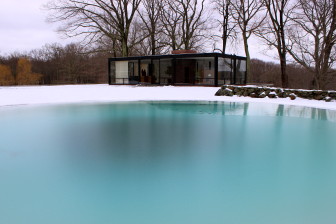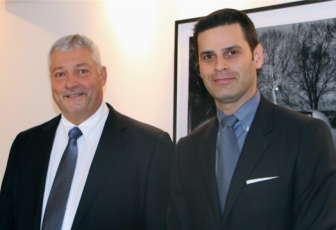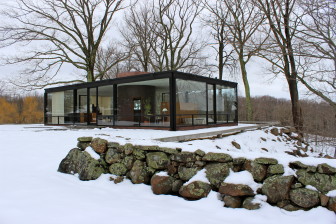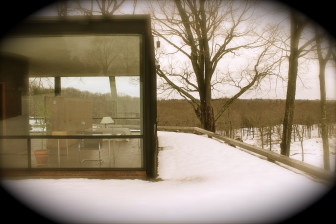Officials from the Philip Johnson Glass House said Tuesday night that the three basic ways they make money at the National Trust for Historic Preservation site—donations, tours (and the gift shop) and one annual fundraiser (the Summer Party)—do not generate sufficient funds to preserve and restore their 49-acre campus and the 14 architecturally significant structures on it.

Philip Johnson Glass House in winter. Credit: Terry DInan
The Glass House has an annual operating budget of $2.6 million and significant, heavily regulated capital needs, according to its executive director, Greg Sages—for example, the re-roofing of the site’s painting gallery, dredging of the pond and restoration of the sculpture gallery—have taken about three years to get done and cost some $3 million.
With the restrictions built into its special operating permit with the town, the $600,000 raised annually through tours “is just not enough, given the backlog of existing work and future work that will obviously need to occur,” Sages told members of the Planning & Zoning Commission at their regular monthly meeting, held at Town Hall.

Philip Johnson Glass House Executive Director Greg Sages stands before the Sculpture Gallery, a 1970 structure that should come back online for the 2016 tour season. Credit: Michael Dinan
“Two areas that can fill the gap are donations and site-based revenue,” Sages said.
Donations are progressing nicely but “the constraints on site-based activity are keeping us from using site to best advantage,” he told P&Z.
“The existing permit precludes even basic site-based events. Persons inquiring about special events invariably want more than 50 persons included in their function, and the existing 5:30 p.m. curfew turns people away. So, The Glass House needs a framework that gives it flexibility to respond affirmatively when that phone call comes in, without delay, in a way that meets the basic parameters of those who want to undertake events.”

Greg Sages is the Philip Johnson Glass House Executive Director, and Scott Drevnig is Deputy Director. Contributed
Specifically, The Glass House is seeking to:
- Raise the baseline headcount allowed on the property at any one time from 50 to 150;
- Allow visitors to remain on the property until 8 p.m. for two weekday evenings per week instead of one;
- Allow visitors to remain on the property one weekend night per month until 10 p.m. during tour season (currently prohibited);
- Increase the headcount allowed on the property during the annual Summer Party fundraiser from 250 to 400;
- Use a service drive at the northern end of the property for construction-related activity as well as drop-off and delivery for special events.
Two neighbors raised concerns about what they viewed as potential negatives in the proposal.

Philip Johnson Glass House in winter. Credit: Terry DInan
Raji Bhagavatula, a next-door neighbor of The Glass House who told P&Z she was speaking on behalf of a group of neighbors, said she would be fine with the organization increasing attendees at its summer fundraiser to 400, but that she worried about increased noise if more regular events such as weddings were held on the property.
Bhagavatula noted that although an event with 150 people—say, a wedding or bar mitzvah—technically represented fewer overall visitors than would come through The Glass House on tours during a regular weekday (a maximum of eight tours with 20 people apiece, or 160 overall), still it represented a more intense use of the property.

Philip Johnson Glass House in winter. Credit: Terry DInan
“I love The Glass House,” she said. “We are really so happy, we feel blessed to be next to it. We enjoy the nature. We love the place. We have worked very hard with them in the past—but respectfully, what they are asking for now is a significant departure from what they have had in the past.”
Karen Snierson of Wing Road said she was concerned that The Glass House was revisiting restrictions that had taken multiple public hearings and compromises on all sides to forge in the first place.

The Glass House Summer Party
06.14.2014
Photo: Sandra Hamburg
“I am concerned for many reasons—one is, you give an inch and they take a mile,” Snierson said, citing the New Canaan Y, Silver Hill Hospital and St. Luke’s School as other institutions located in residential zones that have had widely publicized disagreements with nearby homeowners as they’ve sought to expand their campuses or make other changes.
“I am very concerned that the need for the fundraising is taking over the main purpose of The Glass House,” she said. “We all know their properties need remediation and repair—we all have it in own homes, it is important” but the fundraising focus now proposed by the organization is too big a break from its original purpose, she said.
Commissioners asked Sages and the organization’s attorney— Edward O’Hanlan of Stamford-based Robinson and Cole LLP—what types of additional events The Glass House might host (weddings, bar mitzvahs, corporate functions), whether a proposal to have valet parking would only be for such events (yes, the regular tours would proceed with buses from Elm Street, as in the past), whether special events would include music (probably, and the site has had performance artists there in the past, such a saxophone player and jazz guitarist) and—if their “dreams came true,” how many additional visitors would come to The Glass House (about the same 13,000 annually, since there would be no net gain between tour days and special events).
The most pointed questions from P&Z came from commissioner Dick Ward.
One of the problems that P&Z faces in any case where a business such as The Glass House is operating in a residential zone is “institutional creep,” he said.
“Every few years it seems these institutions come back to us because they are constantly expanding and these are institutions that are in residential areas. And that is the problem we face. And how to maintain a balance between the functioning of an institution—of which most of them are excellent institutions, and it is not a desire on our part to try to condemn it or say it’s not appropriate or not doing a wonderful service for the community. However, there are the residential areas and we have to find some balance. Now, it seems to me that you are asking for a rather dramatic increase from 50 to 150—that is a 300 percent increase.”
Ward also noted that one proposed change to the special operating permit is to eliminate the words ‘public tours’ that had been conditioned, as though The Glass House would, as a result, run private tours that were not subject to conditions.
“I am not saying you intended that, but how else do I read it?” Ward said.
O’Hanlan noted that the special permitting process would allow P&Z to grant The Glass House its new operating plan on a limited basis—say two years—as a trial. Calling the organization’s proposal a “work in progress,” he noted that it’s a financial reality that businesses must be flexible, and underscored that The Glass House is committed protecting its residential neighbors.
“What The Glass House is doing is part of a process, but it is predicated on the belief that it does not intend to change its impact on neighbors,” O’Hanlan said.
Ultimately, P&Z Chairman John Goodwin urged The Glass House and its neighbors to work together and find a mutually agreeable operating plan.
Tucker Murphy of Gerrish Lane said she understood the neighbors’ concerns and felt they were valid, adding that The Glass House is a major draw for New Canaan that has benefitted local businesses. Murphy commended Ward and the commission for working through the tricky balance of weighing an application from an institutional use in a residential zone, and said, “I have seen The Glass House work, firsthand, to be the good neighbor that they are.”
She reminded P&Z that both the Plan of Conservation and Development and Market Demand Study suggested that New Canaan do all it can to support the promotion of the arts and culture in town.
Doug Zumbach of Brooks Road said The Glass House is one-of-a-kind in the world, and urged the community to work hard for a favorable compromise. The owner of Zumbach’s Gourmet Coffee on Pine Street and founder of Caffeine & Carburetors, Zumbach said that in his experience, noise can be controlled—even when it involves 700 vehicles and 4,000 people descending on New Canaan on a Sunday morning.
“I hope the town, neighbors and Glass House can make this work,” he said.
P&Z did unanimously approve Saturday, June 11, as the date for The Glass House’s annual, major fundraiser—whether the number of people allowed on the campus during The Summer Party remains at 250 or goes up to 400 depends on whether the organization can come to an understanding with its neighbors and receive approval from P&Z. The commission is scheduled to meet Feb. 23.